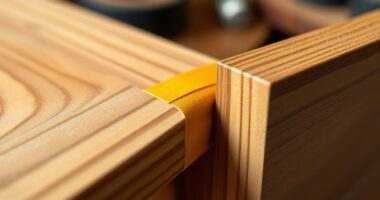Before sanding your veneer, it’s crucial to assess its thickness carefully. Use measuring tools like calipers or specialized gauges to get an accurate reading. This helps you determine how much material can be safely removed without damaging the surface or exposing the substrate. Keep in mind that thinner veneers require gentler techniques to avoid over-sanding, while thicker ones can handle more aggressive smoothing. Understanding your veneer’s thickness ensures a durable, smooth finish—continue to explore effective methods for precise assessment.
Key Takeaways
- Use calipers or specialized gauges to measure veneer thickness accurately before sanding.
- Identify whether the veneer is thin (< 1/16 inch) or thick to determine appropriate sanding techniques.
- Assess the grain pattern to understand how it may respond to sanding and avoid damage.
- Document the measured thickness to guide safe material removal limits during finishing.
- Consider veneer durability and plan gentle sanding if the veneer is thin to prevent damage or exposure of substrate.

Have you ever wondered how the thickness of a veneer impacts its durability and appearance? When you’re preparing to sand a veneer surface, understanding its thickness is essential. Thinner veneers, often less than 1/16 inch, can be delicate and prone to damage if not handled carefully. Thicker veneers, on the other hand, provide more material to work with, making them more forgiving during sanding. But beyond just thickness, the veneer’s grain pattern plays a significant role in how it responds to this process. A pronounced grain pattern might require more gentle, controlled sanding to prevent uneven removal or damage. Recognizing how grain pattern interacts with veneer durability helps you decide the appropriate sanding technique and pressure needed to preserve the overall look.
Assessing veneer thickness before you start sanding isn’t just about avoiding over-sanding; it’s about maintaining the integrity of the veneer’s appearance. If you sand too aggressively on a thin veneer, you risk sanding through the material entirely, exposing the substrate underneath. This can lead to uneven surfaces, visible patches, or even structural weakness. Conversely, thicker veneers allow for more aggressive sanding, which can smooth out surface imperfections without compromising durability. This makes the decision about how much material to remove essential, especially if you’re aiming to enhance the surface’s finish or correct minor defects.
Veneer durability is closely linked to its thickness. Thinner veneers tend to be more delicate and less resistant to wear and tear over time. When you assess the thickness beforehand, you can tailor your sanding approach to extend the life of the veneer. For instance, a very thin veneer might require finer grit sandpaper and lighter strokes, while a thicker veneer can handle a bit more aggressive sanding. By paying attention to the grain pattern, you also avoid disrupting its natural flow and character, which can be compromised by overly harsh sanding.
In practice, measuring veneer thickness with a caliper or a specialized gauge gives you precise information to guide your sanding. Knowing this, you can adjust your technique accordingly, ensuring you don’t compromise the veneer’s durability or its visual appeal. As you evaluate the grain pattern and thickness, you’re better equipped to make informed decisions that preserve the beauty and longevity of the veneer. Ultimately, taking the time to assess these factors before sanding will lead to a flawless finish that highlights the natural elegance of the material, rather than one marred by careless removal or damage.
Frequently Asked Questions
How Often Should Veneer Thickness Be Checked During Sanding?
You should check veneer thickness frequently during sanding, ideally every few passes, to guarantee its durability isn’t compromised. Regular checks help you avoid over-sanding, which reduces veneer strength and affects longevity. This practice also promotes sanding safety, preventing damage to the substrate underneath. By staying vigilant and monitoring veneer thickness often, you maintain the quality of your work while protecting the veneer’s integrity and ensuring a smooth, durable finish.
What Tools Are Best for Measuring Veneer Thickness Accurately?
You’ll want a precision micrometer or a digital caliper for measuring veneer thickness accurately. These tools, when properly calibrated, give you reliable readings. Just remember, moisture content can affect your measurements—so make certain your veneer isn’t swollen or dried out. Ignoring calibration? That’s like trusting a weather forecast from a weatherman with a broken thermometer. Measure carefully, keep your tools calibrated, and watch moisture levels to avoid costly mistakes.
Can Uneven Veneer Thickness Affect the Final Finish Quality?
Uneven veneer thickness can negatively impact the final finish quality. It compromises veneer durability and surface adhesion, leading to uneven surfaces and potential de-lamination. Thinner areas may sand through easily, weakening the veneer, while thicker spots resist finishing, creating an inconsistent appearance. To guarantee a smooth, durable finish, you should inspect and even out veneer thickness before sanding, promoting better adhesion and a higher-quality final result.
How Does Veneer Type Influence Sanding Techniques?
You’ve got to tailor your sanding techniques to the veneer type—different woods, like oak or cherry, respond uniquely. Harder veneers demand a gentler touch, or you risk damaging the surface, especially if veneer durability varies. Always check adhesive compatibility to prevent peeling or lifting. Remember, a one-size-fits-all approach doesn’t work here; adjusting your method guarantees a smooth finish and preserves the veneer’s integrity.
What Signs Indicate Veneer Is Too Thin for Sanding?
You’ll notice signs like uneven surface adhesion, visible wood grain through the veneer, or cracks forming, indicating it’s too thin for sanding. Thin veneer has limited durability and can easily be sanded through, risking damage. If you see areas where the veneer feels fragile or becomes transparent, stop immediately. Properly evaluating veneer thickness helps preserve its durability and ensures a smooth finish without compromising surface adhesion.
Conclusion
Just like a skilled chef gauges ingredients before cooking, you should assess veneer thickness before sanding. This simple step ensures you don’t sand away too much or risk damaging the surface. Taking a moment to measure and evaluate preserves the veneer’s integrity and keeps your project looking flawless. Remember, careful assessment is the foundation of a perfect finish—think of it as the heartbeat of successful woodworking. Stay attentive, and your results will always shine.









